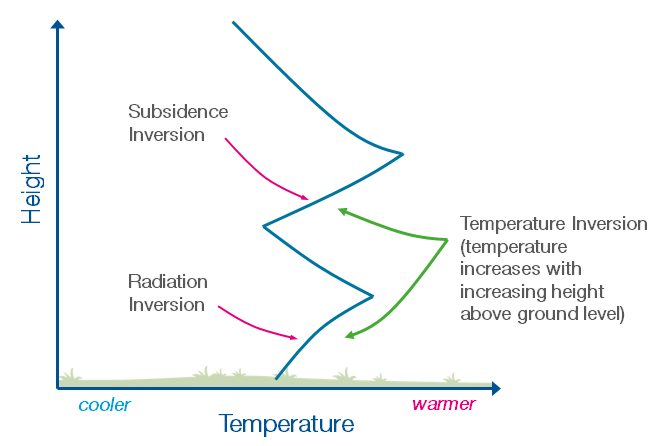In collaboration with the Bureau of Meteorology (WA)
One weather phenomenon which can contribute to the build-up of smoke is a temperature inversion.
Normally, temperatures decrease with height. When temperatures increase with height over a layer of the atmosphere, a temperature inversion is present. Inversions act as a lid and can prevent smoke from dispersing, particularly when the winds below the inversion are light.
Inversions typically occur near regions of high pressure. On a clear, still night, temperatures near the surface cool faster than the air immediately above the surface. When this occurs, a radiation inversion forms and can trap smoke close to the ground. This type of inversion strengthens overnight and is strongest around dawn. The inversion breaks, typically around mid-morning, when the sun heats the ground. The air near the ground can then freely mix with the air above the ground and the smoke can begin to disperse.
Another type of inversion is called a subsidence inversion. This also occurs near regions of high pressure. Air gradually sinking over a wide area warms and causes a higher-level inversion. This type of inversion can trap smoke through a greater depth of the atmosphere and can persist for longer than a radiational inversion. In this situation, smoke can also build-up, particularly if the winds are light below the inversion.
Strong and deep radiational inversions occur more frequently during the cooler months of the year (May to September) whilst subsidence inversions occur more frequently during the warmer months of the year (October to March). This is due to seasonal weather patterns and in particular, the location of the ridge of high pressure.

From time to time and under the right weather conditions, smoke can persist and travel a considerable distance and impact many communities over a number of days.
Smoke can travel hundreds of kilometres in a narrow band when winds in the lower part of the atmosphere converge and the smoke is trapped below an inversion.
The satellite images below show smoke extending many kilometres away from the fires over the southwest of WA.
Images courtesy of NASA Worldview
